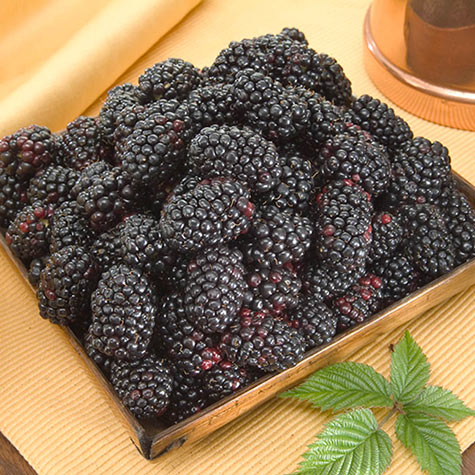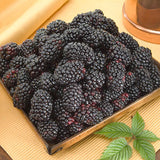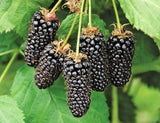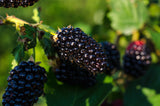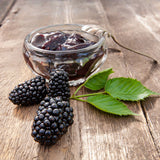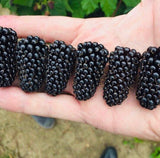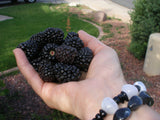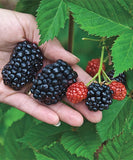Blackberries are hardy plants that are relatively easy to grow. However, growing from seed won't produce berries the first year.
The seeds require stratification the first year and will grow the second year. Blackberries are hardy plants that rarely contract a disease or attract pests.
These Mammoth sized dark black meaty berries are one of the largest blackberry fruit in the existance. Huge produce, a good crop year after year with an amazing flavor.
THE PRODUCE FRUIT STARTING IN EARLY JULY. DELICIOUS IN PIE, DESSERTS, JAMS AND PRESERVES, OR JUST EATING FRESH. EXCELLENT FOR FREEZING. GROWING THEM BY SEED IS A VERY SLOW PROCESS AND WILL TAKE A FEW YEARS TO PRODUCE LARGE CROPS OF FRUIT. 6 FT HIGH BY 8 FT WIDE (MATURE SIZE)
Trailing type requires supports to train canes to grow up and out (naturally grows toward the ground). Disease resistant. New canes can be trained right up through the older floricanes without needing to prune out old canes first, and without any disease problems. Giant berry has great flavor and aromatics. Deer and rabbit resistant. Mature at 5-6 feet. Shows excellent resistance to heat damage. Harvest from late June until the end of July
With a mildly sweet flavor that's perfect for salads, smoothies, jams, and desserts, you can enjoy bountiful yields of thornless, easy-to-pick berries all summer long! Simply provide with full sun and well-drained soil. Resistant to heat, disease, and hungry critters, Blackberry Columbia Giant is ready to prove that sometimes more is more!
Seed Count: ~15
Height: 5-6'
Spread:3-4'
Light Required:Full Sun
Blooms: Late Spring
Zone: 3-9
Form: Edible, Perennial
Flower Form: Fruit
Soil Requirements: Well-drained, rich, slightly acidic moist soil, 5.5- 6.8 pH.
Soil Requirements: Loamy Soil
Pruning: Trim canes to 4' - 5', remove unwanted ones Early spring. When the new shoots of erect blackberries reach thirty to thirty-six inches in height, cut off the tips. This will force branching lower on the canes and will cause the canes to thicken, making them better able to support a heavy fruit crop. During the winter, prune the laterals to twelve to fourteen inches for convenient harvesting and larger berries. In late winter, remove any remaining dead or weak wood. Leave healthy, vigorous canes spaced at six canes per linear foot.
Foliage: Green, Thornless, upright canes
Excellent fruit size
Disease-resistant canes
Tolerates heat and humidity
May produce a second crop in fall
Known for its flavor, vigor and productivity
Extra-sweet, huge berries
Thornless for easy picking
Semi-erect canes
Dense foliage protects plant from sun scale
Columbia Blackberry, Vegetable Seed, Thornless Blackberry, Columbia Giant, Triple Crown Blackberry, Kiowa Blackberry, Rubus Bushel, Dirksens Thornless blackberry, Black Satin blackberry, Oregon Thornless, Thornless Evergreen, Black Cascade, Polarberry , berries, berry seeds, Apache Blackberry, Trailing Blackberries, Chester Blackberry, Prime Ark 45, Black Diamond, Marion Berry, Columbia Star
The seeds require stratification the first year and will grow the second year. Blackberries are hardy plants that rarely contract a disease or attract pests.
These Mammoth sized dark black meaty berries are one of the largest blackberry fruit in the existance. Huge produce, a good crop year after year with an amazing flavor.
THE PRODUCE FRUIT STARTING IN EARLY JULY. DELICIOUS IN PIE, DESSERTS, JAMS AND PRESERVES, OR JUST EATING FRESH. EXCELLENT FOR FREEZING. GROWING THEM BY SEED IS A VERY SLOW PROCESS AND WILL TAKE A FEW YEARS TO PRODUCE LARGE CROPS OF FRUIT. 6 FT HIGH BY 8 FT WIDE (MATURE SIZE)
Trailing type requires supports to train canes to grow up and out (naturally grows toward the ground). Disease resistant. New canes can be trained right up through the older floricanes without needing to prune out old canes first, and without any disease problems. Giant berry has great flavor and aromatics. Deer and rabbit resistant. Mature at 5-6 feet. Shows excellent resistance to heat damage. Harvest from late June until the end of July
With a mildly sweet flavor that's perfect for salads, smoothies, jams, and desserts, you can enjoy bountiful yields of thornless, easy-to-pick berries all summer long! Simply provide with full sun and well-drained soil. Resistant to heat, disease, and hungry critters, Blackberry Columbia Giant is ready to prove that sometimes more is more!
Seed Count: ~15
Height: 5-6'
Spread:3-4'
Light Required:Full Sun
Blooms: Late Spring
Zone: 3-9
Form: Edible, Perennial
Flower Form: Fruit
Soil Requirements: Well-drained, rich, slightly acidic moist soil, 5.5- 6.8 pH.
Soil Requirements: Loamy Soil
Pruning: Trim canes to 4' - 5', remove unwanted ones Early spring. When the new shoots of erect blackberries reach thirty to thirty-six inches in height, cut off the tips. This will force branching lower on the canes and will cause the canes to thicken, making them better able to support a heavy fruit crop. During the winter, prune the laterals to twelve to fourteen inches for convenient harvesting and larger berries. In late winter, remove any remaining dead or weak wood. Leave healthy, vigorous canes spaced at six canes per linear foot.
Foliage: Green, Thornless, upright canes
Excellent fruit size
Disease-resistant canes
Tolerates heat and humidity
May produce a second crop in fall
Known for its flavor, vigor and productivity
Extra-sweet, huge berries
Thornless for easy picking
Semi-erect canes
Dense foliage protects plant from sun scale
Columbia Blackberry, Vegetable Seed, Thornless Blackberry, Columbia Giant, Triple Crown Blackberry, Kiowa Blackberry, Rubus Bushel, Dirksens Thornless blackberry, Black Satin blackberry, Oregon Thornless, Thornless Evergreen, Black Cascade, Polarberry , berries, berry seeds, Apache Blackberry, Trailing Blackberries, Chester Blackberry, Prime Ark 45, Black Diamond, Marion Berry, Columbia Star

